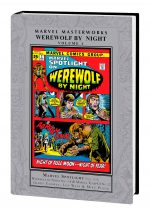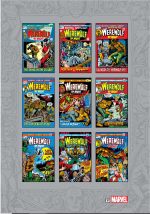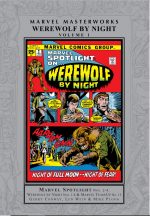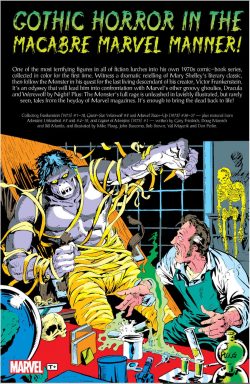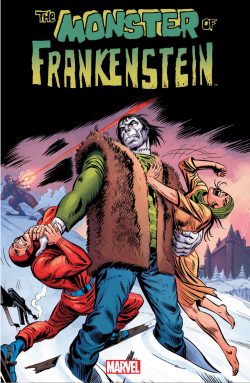

By Tony Isabella, Jim Shooter, Steve Gerber, Bill Mantlo, Marv Wolfman, Gerry Conway, Don Glut, Chris Claremont, Roger McKenzie, Scott Lobdell, Frank Robbins, Don Heck, Sal Buscema, George Tuska, Bob Brown, John Byrne, Gil Kane, Don Perlin, Tom Sutton, Vince Evans, Vince Colletta, Mike Esposito, Jim Mooney, Sam Grainger, Keith Pollard, Don Newton, Dan Green, Pablo Marcos, Tony DeZuñiga, Owen McCarron, Steve Gan, Phil Sheehy & various (MARVEL)
ISBN: 978-1-3029-5549-6 (TPB/Digital edition)
This book includes Discriminatory Content produced in less enlightened times.
Closely reflecting the state of their presumed readership, as the 1960s ended US comic books were in turmoil. Superheroes had dominated for much of the previous decade; peaking globally before explosively falling to ennui and overkill. Established genres like horror, westerns, science fiction and war were returning, fed by contemporary events and radical trends in moviemaking where another, new(ish) wrinkle had also emerged: disenchanted, rebellious, unchained Youth (on Motorbikes …and Drugs!) seeking different ways forward. Moreover, most of us thought that we might well all expire in a nuclear fireball at any moment. How glad I am that we’ve finally returned to those halcyon days…
Green Lantern/Green Arrow, Jack Kirby’s Jimmy Olsen, Captain America and many more took the Easy Rider option to boost flagging sales (and if you’re interested, the best of the crop was Mike Sekowsky’s tragically unfinished mini-masterpiece of cool Jason’s Quest in Showcase). Over at Marvel – a company still reeling from Kirby’s defection to DC in 1970 – canny Roy Thomas green-lit a new character combining that freewheeling, adolescent-friendly biker theme with the all-pervasive supernatural furore gripping entertainment fields.
Back in 1967, Marvel had published a western masked hero named Ghost Rider. He was a shameless, whole-hearted appropriation of the cowboy hero creation of Vince Sullivan, Ray Krank & Dick Ayers (for Magazine Enterprises from 1949 to 1955), initially utilising magician’s tricks to fight bandits by pretending to be an avenging phantom of justice.
Scant years later, with the Comics Code prohibition against horror hastily rewritten – amazing how plunging sales affect ethics – scary comics boomed back in a big way. A new crop of supernatural superheroes and monsters appeared on newsstands, supplementing the ghosts, ghoulies and goblins already infiltrating the once science-only scenarios of surviving mystery man titles.
In fact, diluting the Code ban resulted in such an avalanche of horror titles (new material plus reprints from the first boom in the 1950s), in response to the industry-wide downturn in superhero sales, that it probably caused a few more venerable costumed crusaders to – albeit temporarily – bite the dust.
Almost overnight, nasty monsters became acceptable fare for four-colour pages and, whilst a parade of pre-code reprints made sound business sense, the creative aspects of the fascination in supernatural themes was catered to by adapting popular cultural icons before risking whole new concepts on an untested public. As always in entertainment, the watchword was fashion: what was hitting big outside comics was incorporated into the mix as soon as possible. When proto-monster Morbius, the Living Vampire debuted in Amazing Spider-Man #101 (cover-dated October 1971) and the sky failed to fall in, Marvel moved ahead with a line of shocking superstars – beginning with a werewolf and a vampire – before broadening the scope with a haunted biker tapping both Easy Rider’s freewheeling motorcycling chic and a prevailing supernatural zeitgeist.
Preceded by western hero Red Wolf in #1 and the aforementioned Werewolf by Night in #2-4, the all-new Ghost Rider debuted in Marvel Spotlight #5 (August 1972) and the course of comics was changed forever…
What Has Gone Before: Carnival trick cyclist Johnny Blaze sells his soul to the devil in an attempt to save his foster-father Crash Simpson from cancer. As is the way of such things, Satan follows the letter but not spirit of his contract and Simpson dies anyway – just not from cancer. When the Dark Lord later comes for his prize, Blaze’s beloved virginal girlfriend Roxanne Simpson intervenes. Her purity prevents the Devil from claiming his due so, temporarily thwarted, Satan spitefully afflicts Johnny with a body that burns with the fires of Hell every time the sun goes down…
After months of diabolical persecution with Blaze shaming the Devil daily by using his curse to do good and save souls, everything seemed to change after what looked like Jesus Christ himself intervened to get Satan off his back, but of course nothing is ever what it seems…
Spanning cover-dates March 1975 to February 1978, and re-presenting Ghost Rider (1973) #12-28; Marvel Two-in-One #18; Daredevil (vol. 1) #138; Marvel Team-Up #58; Marvel Premiere #28 and material from 1991’s Marvel Tales (vol. 1) #255, this conflagratory compendium sees Blaze and his infernal alter ego unwillingly dragged deeper into the world of superheroes… but not for long…
Marvel Two-in-One #8 opens proceedings and also explores redemptive themes as Blaze teams with Ben Grimm – AKA The Thing – in a quirkily compelling Yuletide yarn. Crafted by Steve Gerber, Sal Buscema & Mike Esposito, ‘Silent Night… Deadly Night!’ finds the audacious Miracle Man attempting to take control of a very special birth in a modern-day stable…

In Ghost Rider #12 Tony Isabella, Frank Robbins, Frank Giacoia & Mike Esposito reveal the fate of World War I fighter ace Phantom Eagle, as Blaze tries to rescue a stranger from a ghostly aerial assault, only to learn he has inadvertently thwarted justice and helped the noble air warrior’s murderer avoid the ‘Phantom of the Killer Skies’, after which GR #13 and Isabella, George Tuska & Vince Colletta declare ‘You’ve Got a Second Chance, Johnny Blaze!’ as the terms of the hero’s on-going curse are changed again, just as the dissolute biker heads to Hollywood and a previously promised job as TV star Stunt-Master’s body-double. No sooner has he signed up, however, than Blaze becomes involved with Daredevil’s former girlfriend, fresh-faced starlet Karen Page and a bizarre kidnap plot by supervillain The Trapster. As ‘A Specter Stalks the Soundstage!’ Blaze’s revenge-obsessed nemesis The Orb returns to destroy Ghost Rider, an action yarn that spectacularly concludes with ‘Vengeance on the Ventura Freeway!’, as illustrated by Bob Brown & Don Heck.
Whilst hanging out on the West Coast, Blaze joins new superteam The Champions, but they play no part in Bill Mantlo, Tuska & Colletta’s fill-in yarn ‘Blood in the Waters’, as Ghost Rider oh, so topically tangles with a Great White Shark in the gore-soaked California surf.
A much reprinted yarn comes next courtesy of Mantlo, Robbins & Steve Gan: an attempt to create a team of terrors long before its time. Marvel Premiere #28 (February 1976) launched the initial line-up of The Legion of Monsters in ‘There’s a Mountain on Sunset Boulevard!’. When an ancient alien manifests a rocky peak in LA, Werewolf by Night Jack Russell, the macabre Man-Thing, Hollywood stuntman Johnny Blaze and living vampire Michael Morbius are drawn into a bizarre confrontation which might have resulted in the answer to all their wishes and hopes, but instead only leads to destruction, death and crushing disappointment…
Back on track in GR #17, ‘Prelude to a Private Armageddon!’ (Isabella, Robbins & Colletta) triggers a combative and fractious reunion with The Son of Satan when fellow stunt-actor Katy Milner is possessed by a demon and only Daimon Hellstrom can help. The struggle devolves into ‘The Salvation Run!’ as Blaze races through the bowels of Hell, reliving his own traumatic past and at last learning the truth about his own personal Jesus, before finally saving the day on his own terms and merits, rescuing both Katy’s and his own much-tarnished soul in ‘Resurrection’.

All this time the mysterious subplots of Karen’s attempted abduction had percolated through GR, but now explosively boil over into Daredevil #138 as ‘Where is Karen Page?’ (by Marv Wolfman, John Byrne & Jim Mooney) exposes the extensive machinations of deceased criminal maniac Death’s-Head as merely part of a greater scheme involving Blaze, Stunt-Master, the Man without Fear and the homicidal Death Stalker. The convoluted conundrum cataclysmically climaxes in Ghost-Rider #20 with Don Perlin inking Wolfman & Byrne’s ‘Two Against Death!’
After dancing with the Devil and assorted demons for months, and dabbling with team dynamics in the Champions, instinctual loner Blaze’s move to Hollywood had sparked a far more mundane narrative methodology. His glamorous hazardous working gig had brought romantic dalliances, increased interaction with superheroes and supervillains, and more and more clashes with street level crime…
As the action opens in GR #21’s ‘Deathplay!’, Gerry Conway, Gil Kane & Sam Grainger built on the “real world” TV friendly trend as manic super thug for hire The Gladiator attacks the Delazny Studio employing Blaze, seeking a deadly weapon left by a sinister hidden foe. After spectacularly repelling the armoured assassin, Blaze does a little digging into the studio and staff only to clash with another veteran villain – The Eel – abruptly reinforced by an incensed Gladiator seeking a rematch. Thrashing them both only gets Johnny in more trouble with the cops and – on the run again – he finally faces the criminal mastermind who has orchestrated many months of woe. Unfortunately, he learns ‘Nobody Beats the Enforcer!’ (Conway, Don Glut, Don Heck & Keith Pollard)…

The secretive crime lord has his fingers dug deep into the studio and seeks ultimate power in LA, but somehow Blaze is always in his way, such as here, foiling the costumed killer’s attempt to steal a deadly ray concealed in a ring. Attempts to further integrate Ghost Rider with mainstream Marvel continuity intensify with the arrival of new scripter – and actual motorbike afficionado – Jim Shooter. With Dons Heck & Newton illustrating, ‘Wrath of the Water Wizard!’ depicts the embattled biker battling a hydrokinetic hoodlum at the Enforcer’s behest, only to be betrayed and beaten in anticipation of a blockbusting deciding clash in Shooter, Heck & Dan Green’s calamitous concluding climax ‘I, The Enforcer…!’
The end and direction change is emphasised by another crosspollinating adventure as Marvel Team-Up #58 (June 1977 Chris Claremont, Sal Buscema & Pablo Marcos) describes ‘Panic on Pier One!’ as Spider-Man is abducted by The Trapster and how, in saving the hero, damned Johnny Blaze exposes the true nature of his “powers & gimmicks”…
Cover-dated August 1977, (“The New”) Ghost Rider #25 presaged a return to wandering ways as Shooter, Heck & Tony DeZuñiga’s ‘Menace is a Man Called Malice!’ finds our infernal antihero erroneously implicated in an arson attack on a wax museum before battling a high tech madman. Blaze’s diabolical overreaction in victory signalled darkening days ahead…
Don Perlin fully began his long association with the Spirit Cyclist in #26 pencilling ‘A Doom Named Dr. Druid!’ (words by Shooter & inks by Grainger) as recently-revived and revised proto Marvel superhero Anthony Druid (who as Dr. Droom actually predates Fantastic Four #1) hunts a satanic horror and mistakenly attacks Ghost Rider. Only after beating the burning biker does the parapsychologist learn the dreadful error he’s made, but by then Blaze’s secret is exposed, his Hollywood life is ruined and the end of his safe secure life looms…
Back on the road again, Johnny heads for the Mojave desert and encounters two fellow travellers/he-man soulmates, aimless and in trouble. Palling up with disgruntled former Avengers Hawkeye and time-displaced cowboy hero Matt Hawk – The Two-Gun Kid in an atypical moment of Marvel Madness crafted by Shooter, Perlin & Green. ‘At the Mercy of the Manticore!’ sees Blaze save the heroes from The Brand Corporation’s bestial cyborg monstrosity, only to drive them away when his demonic other half’s growing propensity for inflicting suffering gets out of control…

Still roaming the southern deserts, Blaze is then targeted again by his personal Captain Ahab in ‘Evil is the Orb!’ (by Roger McKenzie, Perlin, Tom Sutton, Owen McCarron & Pablo Marcos), when his vengeance-crazed rival abducts Roxie and mesmerises a biker gang into doing his vicious, petty dirty work. However, the villain hasn’t reckoned on an intervention by Blaze’s new biking buddy Brahma Bill…
Although the 1970s sensationalism stops here, there’s one last yarn by Scott Lobdell, Vince Evans & Phil Sheehy (from Marvel Tales #255: November 1991, which reprinted Marvel Team-Up #58) to enjoy. ‘Shock Therapy’ explores what a dose of Blaze’s satanic Hellfire did to the Trapster and what extreme measures were taken to cure him…
This spooky compendium compounds the chilling action with a full cover gallery by Kane, Tom Palmer, Ron Wilson, Sal Buscema, Ed Hannigan, Dave Cockrum, Rich Buckler, Frank Giacoia, Nick Cardy, John Romita Sr., Gene Colan, Klaus Janson, Jack Kirby, Al Milgrom, Steve Leialoha, George Pérez, Ernie Chan and Sam Kieth and includes pertinent images from ‘The Mighty Marvel Bicentennial Calendar 1976’ by Sal B, plus covers from 1990s reprint series The Original Ghost Rider #19-20, by Sal and Mark Buckingham.
Also on view are original art covers and interior pages by Heck, DeZuñiga, Kirby, John Verpoorten, and Romita Sr. to truly complete your fear-filled fun fest.
One final note: backwriting and retcons notwithstanding, the Christian boycotts and moral crusades of the following decade (and ever since) were what compelled criticism-averse and commercially astute corporate Marvel to “translate” the biblical Satan of these tales into generic and presumably more palatable demonic creatures such as Mephisto, Satanish, Marduk Kurios and other equally naff quibbling downgrades. However, the original intent and adventures of Johnny Blaze – and spin-offs Daimon Hellstrom and his sister Satana – respectively Son and Daughter of Satan – tapped into the period’s global fascination with Satanism, Devil-worship and all things Spookily Supernatural which had begun with such epochal breakthroughs as Rosemary’s Baby (Roman Polanski’s 1968 film more than Ira Levin’s novel). Please remember in funnybook terms these aren’t your feeble bowdlerised “Hell-lite” horrors…
These tales are about the real-deal Infernal Realm and a good man struggling to save his soul from the worst of all bargains – as much as the revised Comics Code would allow – so brace yourself, hold steady and accept no supernatural substitutes…
© 2024 MARVEL.





